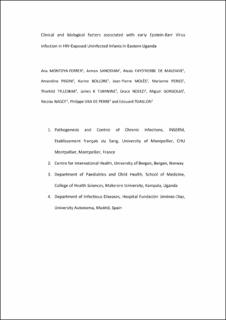| dc.contributor.author | Montoya-Ferrer, Ana | |
| dc.contributor.author | Sanosyan, Armen | |
| dc.contributor.author | Fayd'Herbe De Maudave, Alexis | |
| dc.contributor.author | Pisoni, Amandine | |
| dc.contributor.author | Bollore, Karine | |
| dc.contributor.author | Molès, Jean-Pierre | |
| dc.contributor.author | Peries, Marianne | |
| dc.contributor.author | Tylleskär, Thorkild | |
| dc.contributor.author | Tumwine, James K. | |
| dc.contributor.author | Ndeezi, Grace | |
| dc.contributor.author | Gorgolas, Miguel | |
| dc.contributor.author | Nagot, Nicolas | |
| dc.contributor.author | Van De Perre, Philippe | |
| dc.contributor.author | Tuaillon, Edouard | |
| dc.date.accessioned | 2022-04-04T11:58:46Z | |
| dc.date.available | 2022-04-04T11:58:46Z | |
| dc.date.created | 2021-08-09T13:09:22Z | |
| dc.date.issued | 2021 | |
| dc.identifier.issn | 1058-4838 | |
| dc.identifier.uri | https://hdl.handle.net/11250/2989612 | |
| dc.description.abstract | Background
Immune control of Epstein-Barr virus (EBV) infection is impaired in individuals with HIV. We explored maternal factors associated with EBV acquisition in HIV-exposed uninfected (HEU) infants and the relationship between EBV infection and serious adverse events (SAEs) during the first year of life.
Methods
201 HEU infants from Uganda enrolled in the ANRS 12174 trial were tested for antiviral capsid antigen (anti-VCA) antibodies at week 50. Date of infection was estimated by testing EBV DNA at weeks 1, 6, 14, 26, 38, and 50 postpartum on dried blood spots.
Results
Eighty-seven (43%) infants tested positive for anti-VCA IgG at week 50. Among the 59 infants positive for EBV DNA, 25% were infected within the first 26 weeks. Almost half (12%) were infected before week 14. Shedding of EBV in breast milk was associated with EBV DNA in maternal plasma (P = .009), HIV RNA detection (P = .039), and lower CD4 count (P = .001) and correlated with plasma EBV DNA levels (P = .002). EBV infant infection at week 50 was associated with shedding of EBV in breast milk (P = .009) and young maternal age (P = .029). Occurrence of a clinical SAE, including malaria and pneumonia, was associated with higher levels of EBV DNA in infants (P = .010).
Conclusions
By assessing EBV infection in HEU infants we observed that infection during the first year is determined by HIV and EBV maternal factors and that EBV DNA levels were higher among infants with clinical SAEs. | en_US |
| dc.language.iso | eng | en_US |
| dc.publisher | Oxford University Press | en_US |
| dc.title | Clinical and Biological Factors Associated with Early Epstein-Barr Virus Infection in Human Immunodeficiency Virus-Exposed Uninfected Infants in Eastern Uganda | en_US |
| dc.type | Journal article | en_US |
| dc.type | Peer reviewed | en_US |
| dc.description.version | acceptedVersion | en_US |
| dc.rights.holder | Copyright 2020 The Author(s) | en_US |
| cristin.ispublished | true | |
| cristin.fulltext | postprint | |
| cristin.qualitycode | 2 | |
| dc.identifier.doi | 10.1093/cid/ciaa161 | |
| dc.identifier.cristin | 1924727 | |
| dc.source.journal | Clinical Infectious Diseases | en_US |
| dc.source.pagenumber | 1026-1032 | en_US |
| dc.identifier.citation | Clinical Infectious Diseases. 2021, 72 (6), 1026-1032. | en_US |
| dc.source.volume | 72 | en_US |
| dc.source.issue | 6 | en_US |
